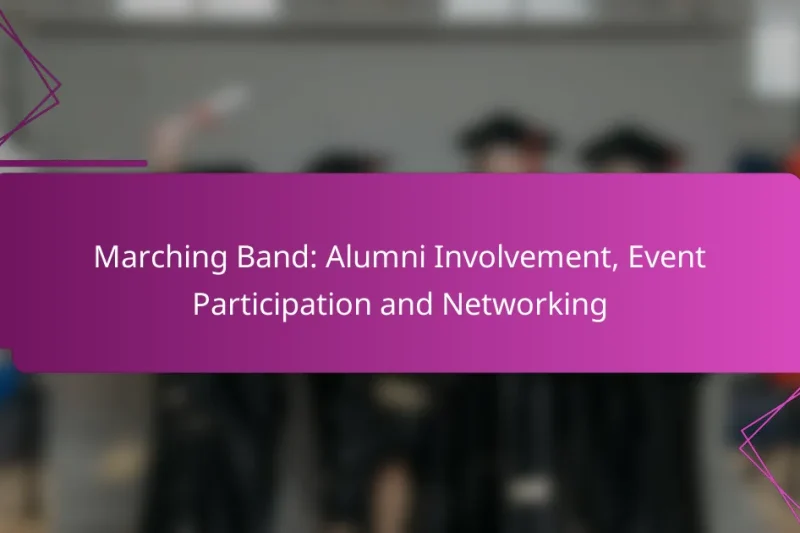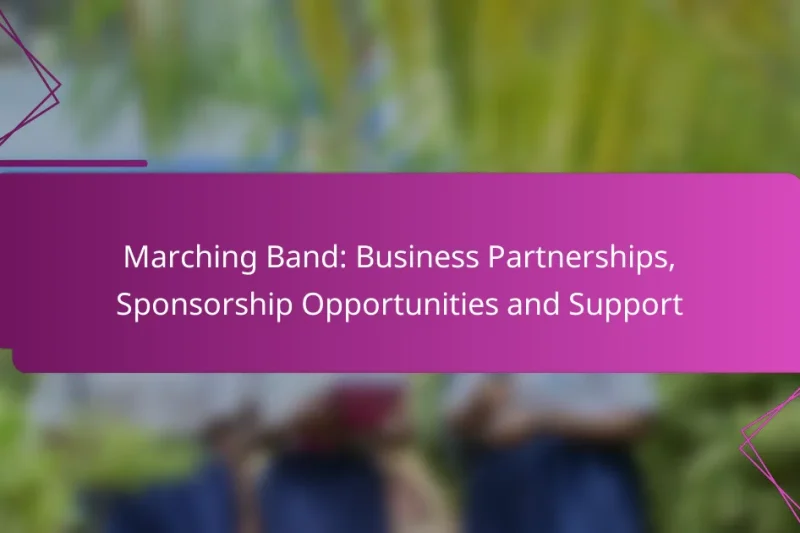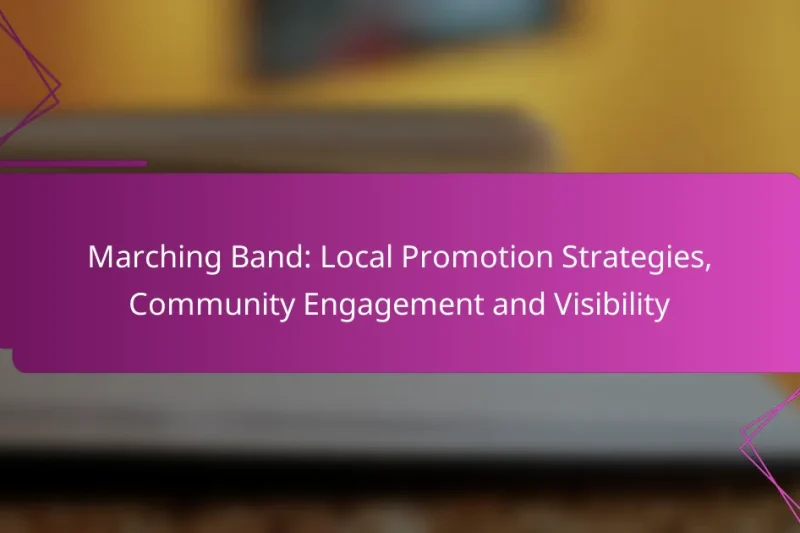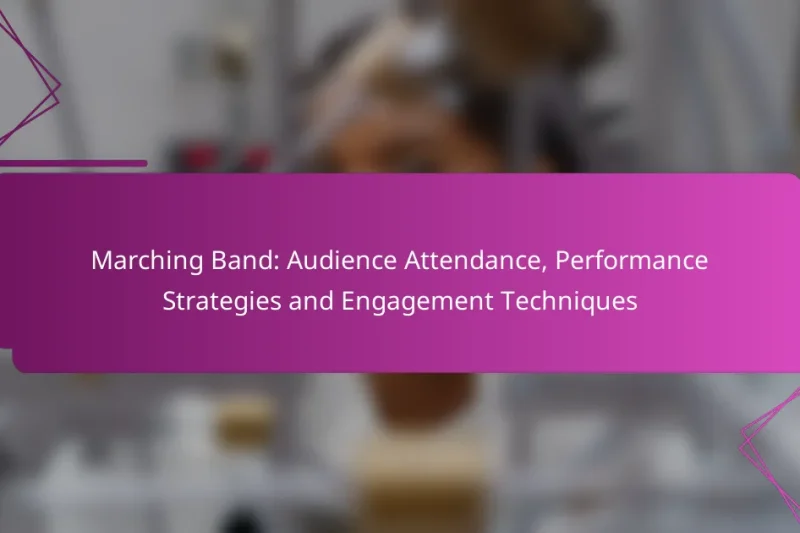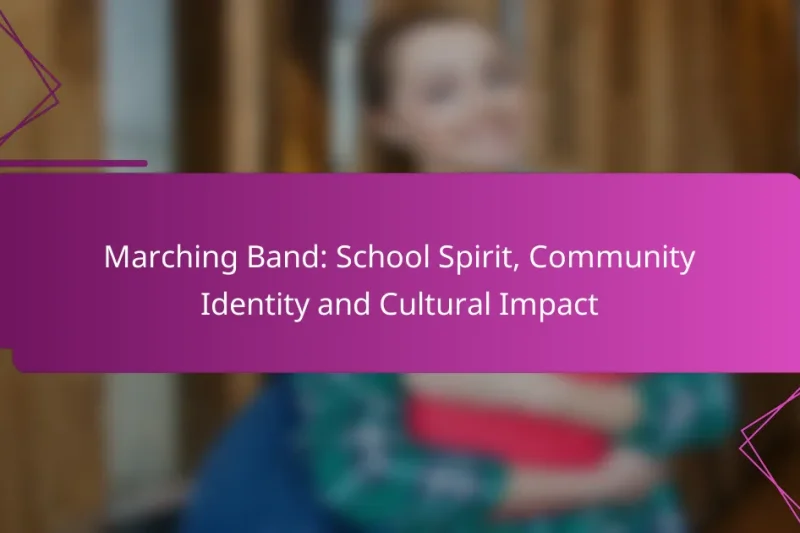Marching bands play a vital role in enhancing community engagement by bridging connections between students, schools, … Marching Band: Outreach Programs, Student Involvement and Community EngagementRead more
Marching Band Community Engagement
Marching bands play a vital role in fostering community engagement through performances, collaborative events, and educational workshops. By actively participating in local culture and connecting with residents, they enhance community spirit and visibility. Effective outreach strategies, such as social media engagement and partnerships with local businesses, can further strengthen these ties and support the band’s success.
Marching Band: Alumni Involvement, Event Participation and Networking
Alumni involvement in marching bands plays a crucial role in strengthening community ties and fostering collaboration. … Marching Band: Alumni Involvement, Event Participation and NetworkingRead more
Marching Band: Business Partnerships, Sponsorship Opportunities and Support
Marching bands can significantly benefit from effective business partnerships that enhance visibility and provide essential financial … Marching Band: Business Partnerships, Sponsorship Opportunities and SupportRead more
Marching Band: Local Promotion Strategies, Community Engagement and Visibility
Marching bands play a vital role in community engagement, and effective local promotion strategies can significantly … Marching Band: Local Promotion Strategies, Community Engagement and VisibilityRead more
Marching Band: Audience Attendance, Performance Strategies and Engagement Techniques
Marching bands have the potential to significantly enhance audience attendance through targeted engagement strategies and effective … Marching Band: Audience Attendance, Performance Strategies and Engagement TechniquesRead more
Marching Band: School Spirit, Community Identity and Cultural Impact
Marching bands play a vital role in enhancing school spirit and fostering community identity across the … Marching Band: School Spirit, Community Identity and Cultural ImpactRead more
How can marching bands engage their local communities?
Marching bands can engage their local communities through performances, collaborative events, fundraising initiatives, and educational workshops. These activities foster connections, promote local culture, and enhance community spirit.
Community performances
Community performances are a direct way for marching bands to showcase their talent and bring people together. These can include parades, local festivals, and public concerts, which often draw significant crowds and create a festive atmosphere.
Consider scheduling performances at popular local events or venues to maximize visibility. Engaging with local businesses for sponsorship or collaboration can also enhance the experience and provide mutual benefits.
Collaborative events with schools
Collaborative events with schools can strengthen ties between marching bands and educational institutions. This could involve joint performances, workshops, or even competitions that encourage student participation and interest in music.
Organizing events like a “Band Night” where students can perform alongside the marching band can inspire young musicians and build a supportive community around music education.
Fundraising initiatives
Fundraising initiatives are essential for sustaining marching band programs and can also engage the community. Activities such as bake sales, car washes, or crowdfunding campaigns can raise necessary funds while involving local residents.
Consider hosting a community event where a portion of ticket sales goes to support the band. This not only raises funds but also increases community participation and investment in the band’s success.
Workshops and clinics
Workshops and clinics provide valuable educational opportunities for aspiring musicians in the community. Marching bands can host sessions focusing on instrument techniques, marching fundamentals, or music theory, catering to various skill levels.
Offering these workshops for free or at a low cost can attract participants and foster a love for music. Collaborating with local music educators can enhance the quality and reach of these programs, making them more appealing to the community.
What are effective strategies for outreach?
Effective outreach strategies for marching bands focus on building community connections and increasing visibility. Utilizing social media, forming partnerships with local businesses, and participating in local festivals can significantly enhance engagement and support.
Social media campaigns
Social media campaigns are a powerful tool for marching bands to reach a wider audience. Platforms like Facebook, Instagram, and Twitter allow bands to share performances, updates, and events, engaging both current and potential supporters.
To maximize impact, create a content calendar that includes regular posts, behind-the-scenes footage, and interactive polls. Aim for a posting frequency of at least two to three times a week to maintain visibility.
Partnerships with local businesses
Forming partnerships with local businesses can provide mutual benefits and strengthen community ties. Businesses may offer sponsorships, donations, or services in exchange for advertising opportunities at events or on social media.
Consider reaching out to local music stores, restaurants, or community centers that align with the band’s values. A well-structured partnership can enhance resources and visibility for both parties.
Participation in local festivals
Participating in local festivals is an excellent way for marching bands to showcase their talent and engage with the community. Events like parades, fairs, and cultural festivals often welcome performances, providing exposure to diverse audiences.
When planning participation, ensure to apply for slots early and prepare a captivating setlist that highlights the band’s strengths. Engaging with festival-goers through interactive activities can further enhance community connection.
What are the benefits of community engagement for marching bands?
Community engagement offers marching bands numerous advantages, including increased visibility, enhanced recruitment opportunities, and stronger ties with local communities. These benefits can lead to greater support, participation, and overall success for the band.
Increased visibility
Increased visibility for marching bands can result from active participation in community events, parades, and local festivals. By performing in public spaces, bands can showcase their talent and attract attention from potential supporters and new members.
To maximize visibility, bands should consider collaborating with local businesses or organizations for sponsorships and joint events. This not only amplifies their reach but also fosters a sense of community ownership over the band.
Enhanced recruitment
Community engagement plays a crucial role in enhancing recruitment for marching bands. By actively involving themselves in local schools and youth programs, bands can create a pipeline of interested students eager to join.
Hosting open rehearsals or workshops can provide a hands-on experience for potential recruits. Offering incentives like scholarships or gear discounts can also motivate students to participate and commit to the band.
Stronger community ties
Stronger community ties are a natural outcome of effective engagement strategies. When marching bands participate in local events, they build relationships with residents and local leaders, fostering goodwill and support.
To strengthen these ties, bands should engage in community service projects or collaborate with local charities. This not only enhances the band’s reputation but also demonstrates their commitment to the community’s well-being.
What resources are available for marching bands?
Marching bands can access a variety of resources to enhance their programs, including grants, sponsorships, and community partnerships. These resources can provide essential funding and support for instruments, uniforms, and travel expenses.
Grants for music programs
Grants for music programs are financial awards that can help marching bands cover costs associated with instruments, uniforms, and educational materials. Organizations such as the National Endowment for the Arts and local arts councils often provide funding specifically for music education.
When applying for grants, it’s important to carefully read the eligibility requirements and deadlines. Many grants require detailed proposals outlining how the funds will be used, so having a clear budget and project plan is essential.
Local sponsorship opportunities
Local businesses often seek to support community initiatives like marching bands through sponsorships. These partnerships can provide funding in exchange for advertising opportunities, such as having the business’s logo displayed on uniforms or promotional materials.
To secure local sponsorships, consider creating a sponsorship proposal that outlines the benefits for the business, such as increased visibility and community goodwill. Networking within the community and attending local events can also help in finding potential sponsors.
How can technology enhance community engagement?
Technology can significantly boost community engagement for marching bands by providing innovative ways to connect with supporters and enhance participation. By leveraging online tools, bands can reach wider audiences, streamline fundraising efforts, and create interactive experiences that foster a sense of community.
Online fundraising platforms
Online fundraising platforms allow marching bands to easily raise money from their community and beyond. These platforms, such as GoFundMe or Kickstarter, enable bands to create campaigns that showcase their goals, share updates, and track donations in real-time.
When using these platforms, it’s crucial to set clear fundraising goals and communicate the impact of donations. Engaging storytelling and visuals can help attract more supporters. Additionally, consider offering incentives for different donation levels, such as exclusive merchandise or recognition in performances.
Virtual performances
Virtual performances provide an opportunity for marching bands to showcase their talent while engaging with audiences online. By streaming performances on platforms like YouTube or Facebook Live, bands can reach fans who may not be able to attend in person, expanding their audience base.
To maximize engagement, promote virtual events through social media and email newsletters. Encourage viewers to interact during the performance by asking questions or sharing their thoughts in real-time. Consider collaborating with local artists or community members to create a more diverse and inclusive experience.
What are the challenges faced in community engagement?
Community engagement in marching bands often encounters several challenges that can hinder effective participation and support. Key issues include a lack of funding, limited visibility, and difficulties in communication with potential community partners.
Lack of funding
A significant challenge in community engagement for marching bands is the lack of funding. Many programs rely on donations, grants, and sponsorships, which can be inconsistent and insufficient to cover operational costs.
To address funding issues, bands can explore various avenues such as local business sponsorships, crowdfunding campaigns, and grant applications. Engaging with community members to highlight the benefits of supporting the band can also encourage financial contributions.
It’s essential to create a budget that outlines expected expenses and potential income sources. Regularly reviewing this budget can help identify funding gaps and inform strategies for securing necessary resources. Consider hosting fundraising events or performances that not only raise money but also increase community awareness and involvement.

